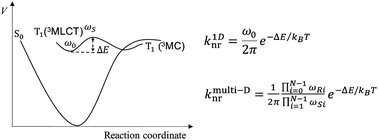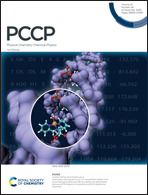Quantitative calculations of the non-radiative rate of phosphorescent Ir(iii) complexes†
Abstract
It has recently been proposed that the dominant non-radiative decay mechanism in blue Ir(III) phosphors at room temperature is due to the low-lying non-radiative metal-centred triplet states. These are populated thermally via an activated transition from the highly radiative metal-to-ligand-charge-transfer states that are initially populated due to intersystem crossing following the radiative or electronic excitation of the phosphor. We apply transition state theory to quantitatively calculate the non-radiative decay rate of a family of Ir(III) complexes containing N-heterocyclic carbene (NHC) ligands. We compare the, computationally inexpensive, one-dimensional theory with the, more accurate, multi-dimensional theory. Both methods find a non-radiative rate with an Arrhenius form (knr = kae−ΔE/kBT). The pre-exponential factors, ka, and activation energies, ΔE, are evaluated via density functional theory (DFT). The multi-dimensional theory shows that there is an order of magnitude variation in ka within this family of materials (between 3 × 1011 s−1 and 3 × 1012 s−1). This is not captured by the one-dimensional theory, which predicts very uniform rate constants in the middle of this range (∼1012 s−1). Nevertheless, the activated process involved, and the linear relationship between ka and knr, mean that ka plays a subtle role in determining knr. Consistent with this we find that both methods capture the trend observed experimentally in the non-radiative rates. Furthermore, the magnitude of the calculated knr is similar in both methods and in good agreement with experimental values [except for one complex with a very shallow activation barrier (<0.1 eV)]. It has previously been demonstrated that radiative decay rates can be accurately calculated from DFT. Combined with our results for the non-radiative rates, this implies that DFT methods can accurately predict the emission efficiency in Ir(III) phosphors. Therefore, DFT calculations are both fast and accurate enough to play a significant role in the design of new deep blue Ir(III) phosphors with high emission efficiency. Even the one-dimensional theory provides reasonable agreement with experiment. This suggests that a funneling approach – where only the best performing molecules, according to the one-dimensional theory, are studied in the more laborious multi-dimensional framework – could be a powerful strategy for designing active materials for phosphorescent organic light-emitting diodes (PHOLEDs) from first principles.

- This article is part of the themed collection: Quantum Theory: The Challenge of Transition Metal Complexes


 Please wait while we load your content...
Please wait while we load your content...